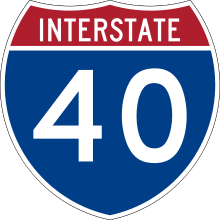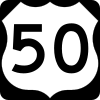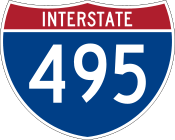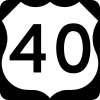U.S. Route 29
| |
|---|---|
 | |
| Route information | |
| Length: | 1,036 mi[1] (1,667 km) |
| Existed: | 1926[1] – present |
| Major junctions | |
| South end: |
|
|
| |
| North end: |
|
| Location | |
| States: | Florida, Alabama, Georgia, South Carolina, North Carolina, Virginia, District of Columbia, Maryland |
| Highway system | |
U.S. Route 29 (US 29) is a north–south United States highway that runs for 1,036 miles (1,667 km) from Pensacola, Florida to the western suburbs of Baltimore, Maryland. This highway's southern terminus is at US 90 and US 98 in Pensacola, Florida. Its northern terminus is at Maryland Route 99 in Ellicott City, Maryland.
The section of US 29 between Greensboro, North Carolina, and Danville, Virginia, has been designated as Future Interstate 785 and has received "Future Interstate" signs in several locations along that route. It will become an official Interstate Highway once improvements have been completed.
From Tuskegee, Alabama to Greensboro, North Carolina, Interstate 85 (I-85) runs parallel with US 29, which along that stretch, serves primarily as a local route.
Route description
| mi | km | |
|---|---|---|
| FL | 43.636 | 70.225 |
| AL | 226.550 | 364.597 |
| GA | 207 | 333 |
| SC | 106.4 | 171.2 |
| NC | 168 | 270 |
| VA | 248 | 399 |
| DC | 5.5 | 8.9 |
| MD | 25.859 | 41.616 |
| Total | 1,036 | 1,667 |
Florida
US 29 begins at U.S. Route 90 and U.S. Route 98 in downtown Pensacola, Florida. Throughout the state, U.S. 29 is twinned with the unsigned State Road 95.
The entire route in Florida runs within Escambia County. From its terminus north to State Road 296, it is known as North Palafox Street. From this point it is known as Pensacola Boulevard north to Ten Mile Road, approximately one mile north of U.S. Route 90 Alternate. Between SR 296 and the Molino community, U.S. 29 runs parallel to its former routing, which is now County Road 95A. This former routing continues the name North Palafox Street from SR 296 north to Ten Mile Road.
Alabama
US 29, internally designated by the Alabama Department of Transportation as State Route 15 (SR-15), is a southwest-northeast state highway across the southeastern part of the U.S. state of Alabama. SR-15 ends in Brewton at a junction with US-31 (SR-3) and SR-41, but US-29 continues west with US-31/SR-3 to Flomaton and south on SR-113 to the Florida state line.
U.S. Highway 29 and SR-15 traverse Alabama in a general northeast/southwest slope. It has never been a major route in the state; its significance was completely overshadowed with the completion of Interstate 65 and Interstate 85 during the 1970s. Today, US-29 and SR-15 serve primarily to connect numerous smaller towns and cities in the southwest, south-central, and eastern parts of Alabama, notably passing through Auburn University, and near Troy University, and Tuskegee University in the east.
US Highway 29 no longer passes through downtown Auburn or downtown Opelika. The US Highway is concurrent with Interstate Highway 85 from Exit 51, south of Auburn, to Exit 62, north of Opelika. This change was made by Alabama Department if Transportation in the 1990s. Route markers have been appropriately relocated since then.
Georgia
US 29 passes through the northern portion of Georgia, serving Atlanta and Athens. The highway passes by notable universities, such as Georgia Tech and Emory University in Atlanta and the University of Georgia in Athens. US 29 also meanders through Hartwell and the Lake Hartwell region near the South Carolina border. From West Point, Georgia (Just south of LaGrange, Georgia) at the Alabama-Georgia Line to downtown Atlanta, Georgia State Route 8 and Georgia State Route 14 are paired with US 29 at various points in the state. US 29 to the southwest of Atlanta has been named Roosevelt Highway, since Franklin D. Roosevelt made his final journey northward from Warm Springs along this stretch of highway. Large crowds gathered along US 29 on this day in April 1945 to pay their final respects to the deceased President. Unfortunately for those who waited along the highway they missed seeing the president's body being transported back to Washington on a train than ran on nearby tracks.
South Carolina
In South Carolina, US 29 maintains a northeasterly routing, passing through Anderson, Greenville, and Spartanburg.
From Greenville through Greer, US 29 is known as Wade Hampton Boulevard. It is a major commercial artery for both Greer and Taylors. A six-lane highway, the road forms the western border of Bob Jones University and then passes near Chick Springs, a mineral springs that served as the focus of a small but important resort community during the nineteenth century.
US 29 was built as the main highway between Greenville and the other city of northwestern South Carolina, Spartanburg. The construction of Interstate 85 connecting Greenville to Spartanburg left US 29 underused until recent decades.
North Carolina
In North Carolina, US 29 connects the cities of Gastonia, Charlotte, Concord, Salisbury, High Point, and Greensboro. US 29 routes through Charlotte along Tryon Street, one of the main arteries that runs through uptown Charlotte.
Virginia
In Virginia, part of U.S. 29 is named the Lee Highway. U.S. 29 connects the historic small cities and large towns of west-central Virginia, including Danville, Lynchburg, Charlottesville, Culpeper, Warrenton, Manassas, Fairfax, and Falls Church, with Arlington, and Washington, D.C., to the northeast, and with North Carolina to the southwest.
Along its route in Virginia, U.S. 29 provides significant access to and from several major colleges and universities, including the University of Virginia in Charlottesville, George Mason University in Fairfax, Sweet Briar College in Sweet Briar, and Liberty University, Lynchburg College, and Randolph College in Lynchburg.
District of Columbia
US 29 enters Washington, D.C., via the Francis Scott Key Bridge adjacent to Georgetown University. The designation turns east onto the Whitehurst Freeway, bypassing Georgetown to the south. Upon crossing Rock Creek, the freeway ends, becoming the at-grade K Street. US 29 remains on K Street to 11th Street, where US 29 turns north onto 11th for seven blocks. At Rhode Island Avenue, US 29 turns right. US 29 northbound turns left at 6th Street NW (touching US 1 where it turns from Rhode Island Avenue to 6th Street); it follows 6th Street NW for two blocks and then turns left onto Florida Avenue NW, where it then turns right onto Georgia Avenue NW. US 29 southbound at this point, however, follows 7th Street, NW to Rhode Island Avenue NW. The route maintains a northerly routing as it passes through northern Washington, D.C. and enters Maryland. During its alignment with Georgia Avenue NW, US 29 bypasses the Howard University campus to the west.
Maryland
In Maryland, US 29 turns northeast onto Colesville Road, interchanges with the Capital Beltway (Interstate 495), becomes Columbia Pike, and interchanges with New Hampshire Avenue (Maryland Route 650), Maryland Route 200 (known as the Intercounty Connector), Maryland Route 198, Maryland Route 32, Maryland Route 175, Maryland Route 100, US 40 and I-70 before terminating at Maryland Route 99 northwest of Ellicott City.
History
.svg.png)
Warrenton Turnpike is the former name of US 29 through Prince William County, Virginia. This is the name that was used for this road during the Civil War. Although the road has been expanded past Manassas into four lanes, it remains a rural two lane highway through Manassas National Battlefield Park, where Interstate 66 carries through traffic. On either side of the road through the battlefield, split rail fences define property borders. The route has also been called the Bill-Beth Highway as it was the name of the children of the original highway developer.
U.S. Route 170
| |
|---|---|
| Location: | Charlotte, North Carolina–Lynchburg, Virginia |
| Existed: | 1926–1931[2] |
The portion of US 29 from US 70 at Charlotte, North Carolina northeast to Lynchburg, Virginia was U.S. Route 170 from 1926 until 1931, when US 29 was extended over it.[2]
Major intersections
- Florida
-

 US 90 / US 98 in Pensacola
US 90 / US 98 in Pensacola -
 I‑10 on the Brent–Ensley line
I‑10 on the Brent–Ensley line - Alabama
-
 US 31 in Flomaton. The highways travel concurrently to Brewton.
US 31 in Flomaton. The highways travel concurrently to Brewton. -
 US 84 in Andalusia. The highways travel concurrently through the city.
US 84 in Andalusia. The highways travel concurrently through the city. -
 US 331 in Brantley. The highways travel concurrently to Luverne.
US 331 in Brantley. The highways travel concurrently to Luverne. -
 US 231 in Troy
US 231 in Troy -
 US 82 in Union Springs. The highways travel concurrently through the city.
US 82 in Union Springs. The highways travel concurrently through the city. -
 US 80 in Tuskegee. The highways travel concurrently to Tuskegee National Forest.
US 80 in Tuskegee. The highways travel concurrently to Tuskegee National Forest. -
 I‑85 in Auburn. The highways travel concurrently to Opelika.
I‑85 in Auburn. The highways travel concurrently to Opelika. -
 US 280 in Opelika. The highways travel concurrently through the city.
US 280 in Opelika. The highways travel concurrently through the city. -

 US 280 / US 431 in Opelika
US 280 / US 431 in Opelika -
 I‑85 on the Valley–Lanett city line
I‑85 on the Valley–Lanett city line - Georgia
-
 US 27 in LaGrange. The highways travel concurrently through the city.
US 27 in LaGrange. The highways travel concurrently through the city. -
 I‑85 in Grantville
I‑85 in Grantville -
 I‑85 south of East Newnan
I‑85 south of East Newnan -
 I‑285 southwest of College Park
I‑285 southwest of College Park -

 US 19 / US 41 in Atlanta. The highways travel concurrently through the city.
US 19 / US 41 in Atlanta. The highways travel concurrently through the city. -

 US 78 / US 278 in Atlanta. US 29/US 78 travel concurrently to the Scottdale–North Decatur city line. US 29/US 278 travel concurrently to Druid Hills.
US 78 / US 278 in Atlanta. US 29/US 78 travel concurrently to the Scottdale–North Decatur city line. US 29/US 278 travel concurrently to Druid Hills. -
 US 23 in Atlanta. The highways travel concurrently to Decatur.
US 23 in Atlanta. The highways travel concurrently to Decatur. -
 I‑285 in Tucker
I‑285 in Tucker -
 US 78 southeast of Bogart. The highways travel concurrently to Athens.
US 78 southeast of Bogart. The highways travel concurrently to Athens. -

 US 129 / US 441 in Athens. The highways travel concurrently through the city.
US 129 / US 441 in Athens. The highways travel concurrently through the city. - South Carolina
-

 US 76 / US 178 in Anderson. The highways travel concurrently through the city.
US 76 / US 178 in Anderson. The highways travel concurrently through the city. -
 I‑85 west of Piedmont. The highways travel concurrently to south-southwest of Dunean.
I‑85 west of Piedmont. The highways travel concurrently to south-southwest of Dunean. -

 I‑85 / I‑185 south-southwest of Dunean
I‑85 / I‑185 south-southwest of Dunean -
 US 25 south-southwest of Dunean
US 25 south-southwest of Dunean -
 US 123 in Greenville
US 123 in Greenville -
 I‑85 in Startex
I‑85 in Startex -
 I‑26 west of Spartanburg
I‑26 west of Spartanburg -
 I‑85 northeast of Blacksburg
I‑85 northeast of Blacksburg - North Carolina
-
 I‑85 southwest of Kings Mountain. The highways travel concurrently through the city.
I‑85 southwest of Kings Mountain. The highways travel concurrently through the city. -

 I‑85 / US 74 in Kings Mountain. US 29/US 74 travel concurrently to Charlotte.
I‑85 / US 74 in Kings Mountain. US 29/US 74 travel concurrently to Charlotte. -
 US 321 in Gastonia
US 321 in Gastonia -
 I‑485 west of Charlotte
I‑485 west of Charlotte -

 I‑77 / US 21 in Charlotte
I‑77 / US 21 in Charlotte -
 I‑277 in Charlotte
I‑277 in Charlotte -
 I‑485 northeast of Charlotte
I‑485 northeast of Charlotte -
 US 601 in Concord. The highways travel concurrently through the city.
US 601 in Concord. The highways travel concurrently through the city. -

 I‑85 / US 601 in Concord
I‑85 / US 601 in Concord -

 US 70 / US 601 in Salisbury. US 29/US 70 travel concurrently to Greensboro.
US 70 / US 601 in Salisbury. US 29/US 70 travel concurrently to Greensboro. -

 I‑85 / US 52 northeast of Spencer. The highways travel concurrently to Lexington.
I‑85 / US 52 northeast of Spencer. The highways travel concurrently to Lexington. -
 US 64 in Lexington. The highways travel concurrently through the city.
US 64 in Lexington. The highways travel concurrently through the city. -

 I‑74 / US 311 in High Point
I‑74 / US 311 in High Point -
 I‑85 south-southwest of Greensboro. The highways travel concurrently to southwest of Greensboro.
I‑85 south-southwest of Greensboro. The highways travel concurrently to southwest of Greensboro. -
 US 220 in Greensboro
US 220 in Greensboro -

 I‑40 / US 220 in Greensboro. The highways travel concurrently through the city.
I‑40 / US 220 in Greensboro. The highways travel concurrently through the city. -

 US 70 / US 220 in Greensboro
US 70 / US 220 in Greensboro -
.svg.png)
 Future I‑785 / I‑840 in Greensboro
Future I‑785 / I‑840 in Greensboro -
 US 158 east of Reidsville
US 158 east of Reidsville - Virginia
-
 US 58 on the Virginia state line at Danville. The highways travel concurrently through the city.
US 58 on the Virginia state line at Danville. The highways travel concurrently through the city. -

 US 58 / US 360 in Danville
US 58 / US 360 in Danville -
 US 460 south of Lynchburg. The highways travel concurrently to east of Lynchburg.
US 460 south of Lynchburg. The highways travel concurrently to east of Lynchburg. -
 US 501 in Lynchburg. The highways travel concurrently through the city.
US 501 in Lynchburg. The highways travel concurrently through the city. -
 US 60 in Amherst
US 60 in Amherst -
 I‑64 west-southwest of Charlottesville
I‑64 west-southwest of Charlottesville -
 US 250 west-northwest of Charlottesville. The highways travel concurrently to Charlottesville.
US 250 west-northwest of Charlottesville. The highways travel concurrently to Charlottesville. -
 US 33 in Ruckersville
US 33 in Ruckersville -
 US 15 south-southwest of Culpeper. The highways travel concurrently to Gainesville.
US 15 south-southwest of Culpeper. The highways travel concurrently to Gainesville. -
 US 522 south-southeast of Culpeper
US 522 south-southeast of Culpeper -
 US 17 in Opal. The highways travel concurrently to Warrenton.
US 17 in Opal. The highways travel concurrently to Warrenton. -
 I‑66 in Gainesville
I‑66 in Gainesville -
 I‑66 in Centreville
I‑66 in Centreville -
 US 50 in Fairfax. The highways travel concurrently through the city.
US 50 in Fairfax. The highways travel concurrently through the city. -
 I‑495 on the Merrifield–West Falls Church city line
I‑495 on the Merrifield–West Falls Church city line -
 I‑66 in Arlington
I‑66 in Arlington -
 I‑66 in Arlington
I‑66 in Arlington -
 I‑66 in Arlington
I‑66 in Arlington - District of Columbia
-
 I‑66 in Washington, D.C.
I‑66 in Washington, D.C. -
 US 1 in Washington
US 1 in Washington - Maryland
-
 I‑495 in Silver Spring
I‑495 in Silver Spring -
 US 40 in Ellicott City
US 40 in Ellicott City -
 I‑70 in Ellicott City
I‑70 in Ellicott City -
 MD 99 in Ellicott City
MD 99 in Ellicott City
See also
References
- 1 2 US Highways from US 1 to US 830 Robert V. Droz
- 1 2 Weingroff, Richard (November 18, 2015). "U.S. 29 Maryland to Florida". Washington, D.C.: Federal Highway Administration. Retrieved July 24, 2016.
External links
| Wikimedia Commons has media related to U.S. Route 29. |
| Browse numbered routes | ||||
|---|---|---|---|---|
| ← | FL | SR 29 | ||
| ← | SR 97 | |||
| ← | AL | SR 30 | ||
